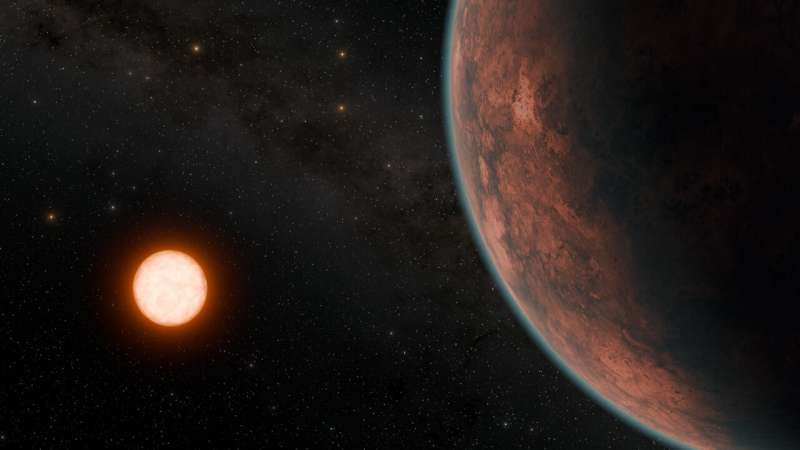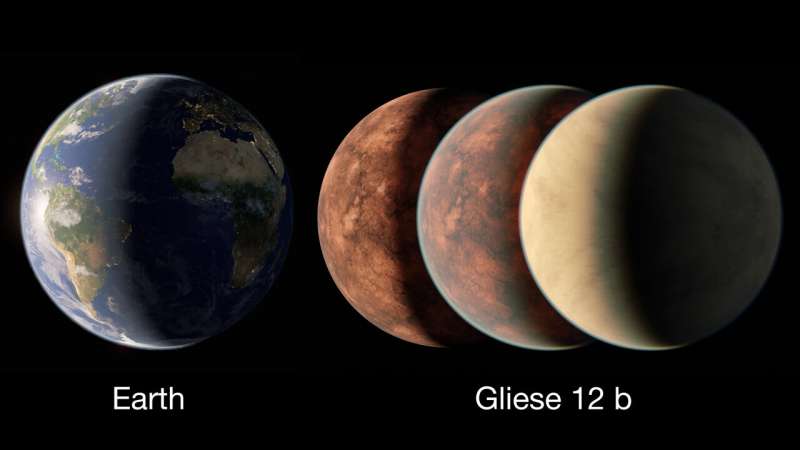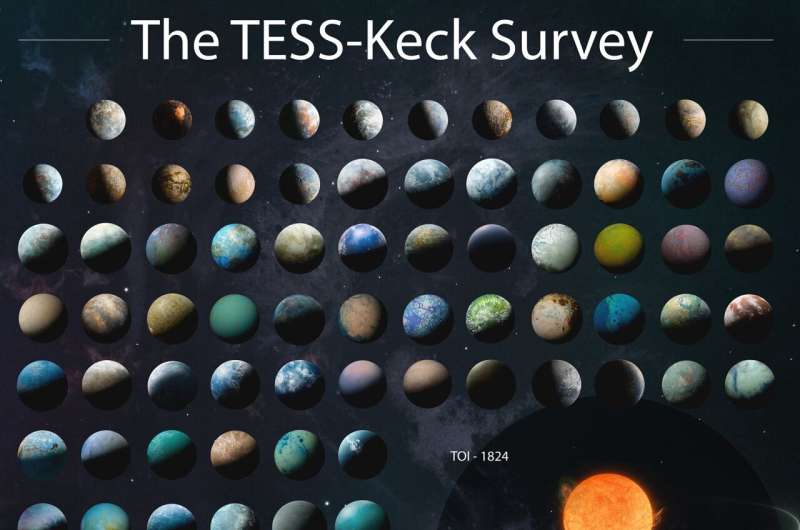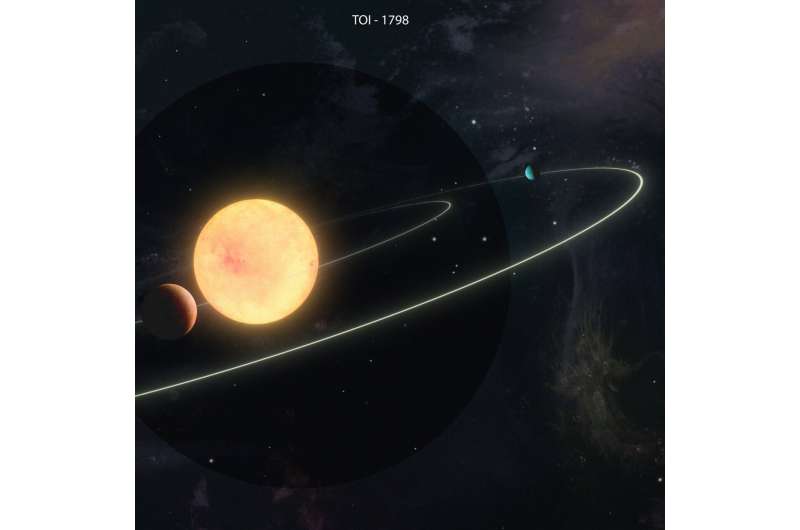
Astronomers have made the rare and tantalizing discovery of an Earth-like exoplanet 40 light-years away that may be just a little warmer than our own world. The new paper “Gliese 12 b, A Temperate Earth-sized Planet at 12 Parsecs Discovered with TESS and CHEOPS,” has been published in the Monthly Notices of the Royal Astronomical Society.
The potentially habitable planet, named Gliese 12 b, orbits its host star every 12.8 days, is comparable in size to Venus—so slightly smaller than Earth—and has an estimated surface temperature of 42°C (107°F), which is lower than most of the 5,000-odd exoplanets confirmed so far.
That is assuming it has no atmosphere, however, which is the crucial next step to establishing if it is habitable. It may have an Earth-like atmosphere, one more akin to Venus—which experienced a runaway greenhouse effect that made it a 400°C (752°F) hellhole—no atmosphere, or perhaps a different kind of atmosphere not found in our solar system.
Getting an answer is vital because it would reveal if Gliese 12 b can maintain temperatures suitable for liquid water—and possibly life—to exist on its surface, while also unlocking answers about how and why Earth and Venus evolved so differently.
Gliese 12 b is by no means the first Earth-like exoplanet to have been discovered, but as NASA has said, there are only a handful of worlds like it that warrant a closer look.
It has been billed as “the nearest, transiting, temperate, Earth-size world located to date” and a potential target for further investigation by the James Webb Space Telescope.
The closest Earth-like exoplanet to us—and possibly the most famous—is Proxima Centauri b, which is only four light-years away. However, because it is not a transiting world, we still have a lot to learn about it, including whether it has an atmosphere and the potential to harbor life.
Most exoplanets are discovered using the transit method, where a planet passes in front of its star from our point of view, causing a dip in the host star’s brightness.
During a transit, the star’s light also passes through an exoplanet’s atmosphere and some wavelengths get absorbed. Different gas molecules absorb different colors, so the transit provides a set of chemical fingerprints that can be detected by telescopes like Webb.
Gliese 12 b could also be significant because it may help reveal whether the majority of stars in our Milky Way galaxy—i.e. cool stars—are capable of hosting temperate planets that have atmospheres and are therefore habitable.
It orbits a cool red dwarf star called Gliese 12, which is almost 40 light-years away from Earth in the constellation Pisces.
“Gliese 12 b represents one of the best targets to study whether Earth-size planets orbiting cool stars can retain their atmospheres, a crucial step to advance our understanding of habitability on planets across our galaxy,” said Shishir Dholakia, a doctoral student at the Center for Astrophysics at the University of Southern Queensland in Australia.
He co-led a research team with Larissa Palethorpe, a doctoral student at the University of Edinburgh and University College London.
The exoplanet’s host star is about 27% of the size of our sun and has a surface temperature that is around 60% of our own star.
However, the distance separating Gliese 12 and the new planet is just 7% of the distance between Earth and the sun. Gliese 12 b therefore receives 1.6 times more energy from its star as Earth does from the sun and about 85% of what Venus experiences.

This difference in solar radiation is important because it means the planet’s surface temperature is highly dependent on its atmospheric conditions. As a comparison to Gliese 12 b’s estimated surface temperature of 42°C (107°F), Earth has an average surface temperature of 15°C (59°F).
“Atmospheres trap heat and—depending on the type—can change the actual surface temperature substantially,” Dholakia explained. “We are quoting the planet’s ‘equilibrium temperature,” which is the temperature the planet would be if it had no atmosphere.
“Much of the scientific value of this planet is to understand what kind of atmosphere it could have. Since Gliese 12 b gets in between the amount of light as Earth and Venus get from the sun, it will be valuable for bridging the gap between these two planets in our solar system.”
Palethorpe added, “It is thought that Earth’s and Venus’s first atmospheres were stripped away and then replenished by volcanic outgassing and bombardments from residual material in the solar system.
“The Earth is habitable, but Venus is not due to its complete loss of water. Because Gliese 12 b is between Earth and Venus in temperature, its atmosphere could teach us a lot about the habitability pathways planets take as they develop.”
The researchers, along with another team in Tokyo, used observations by NASA’s TESS (Transiting Exoplanet Survey Satellite) to help make their discovery.
“We’ve found the nearest, transiting, temperate, Earth-size world located to date,” said Masayuki Kuzuhara, a project assistant professor at the Astrobiology Center in Tokyo, who co-led a research team with Akihiko Fukui, a project assistant professor at the University of Tokyo.
“Although we don’t yet know whether it possesses an atmosphere, we’ve been thinking of it as an exo-Venus, with similar size and energy received from its star as our planetary neighbor in the solar system.”
An important factor in retaining an atmosphere is the storminess of its star. Red dwarfs tend to be magnetically active, resulting in frequent, powerful X-ray flares.
However, analyses by both teams conclude that Gliese 12 shows no signs of such extreme behavior, raising hopes that Gliese 12 b’s atmosphere may still be intact.
“We know of only a handful of temperate planets similar to Earth that are both close enough to us and meet other criteria needed for this kind of study, called transmission spectroscopy, using current facilities,” said Michael McElwain, a research astrophysicist at NASA’s Goddard Space Flight Center in Greenbelt, Maryland, and a co-author of the Kuzuhara and Fukui paper.
“To better understand the diversity of atmospheres and evolutionary outcomes for these planets, we need more examples like Gliese 12 b.”
At 40 light-years from Earth, Gliese 12 b is about the same distance as the TRAPPIST-1 system.
This is made up of seven planets, all roughly in Earth’s size range and likely rocky, orbiting a red dwarf star.
Three of these are in the habitable zone but at least two—and probably all of them—have no atmosphere and are likely barren, dismissing hopes when they were first discovered eight years ago that they could be water worlds hosting life.
More information: Shishir Dholakia et al, Gliese 12 b, A Temperate Earth-sized Planet at 12 Parsecs Discovered with TESS and CHEOPS, Monthly Notices of the Royal Astronomical Society (2024). DOI: 10.1093/mnras/stae1152
Journal information: Monthly Notices of the Royal Astronomical Society
Provided by Royal Astronomical Society
International planet hunters unveil massive catalog of strange worlds
by Jules Bernstein, University of California – Riverside

While thousands of planets have been discovered around other stars, relatively little is known about them. A NASA catalog featuring 126 exotic, newly discovered worlds includes detailed measurements that allow for comparisons with our own solar system.
The catalog details a fascinating mix of planet types beyond our solar system, from rare worlds with extreme environments to ones that could possibly support life.
The planets were analyzed by a large, international team of scientists using NASA’s Transiting Exoplanet Survey Satellite (TESS) in collaboration with the W.M. Keck Observatory on Maunakea, Hawai’i. They are described in today’s edition of The Astrophysical Journal Supplement Series.
“Relatively few of the previously known exoplanets have a measurement of both the mass and the radius. The combination of these measurements tell us what the planets could be made of and how they formed,” said Stephen Kane, UC Riverside astrophysicist and principal investigator of the TESS-Keck Survey.
“With this information, we can begin to answer questions about where our solar system fits in to the grand tapestry of other planetary systems,” Kane said.
The research team spent three years developing the catalog. They analyzed more than 13,000 radial velocity (RV) measurements to calculate the masses of 120 confirmed planets, plus six candidate planets, spread out over the northern sky.
Though the planets themselves aren’t visible, they do have a visible effect. As they orbit, the planets tug on their host stars, causing them to “wobble.” When the star moves toward a telescope, its visible light turns slightly bluer; when it moves away from us, the light shifts slightly redder.
This is much like how sound behaves. Due to the Doppler effect, a fire truck’s siren gets higher-pitched as it travels closer and sounds lower-pitched as it drives farther away.
“These RV measurements let astronomers detect and learn the properties of these exoplanetary systems. When we see a star wobbling regularly back and forth, we can infer the presence of an orbiting planet and measure the planet’s mass,” said Ian Crossfield, University of Kansas astrophysicist and catalog co-author.
Several planets in the TESS-Keck Survey stand out as touchstones for deepening astronomers’ understanding of the diverse ways planets form and evolve.
A related survey paper published in The Astronomical Journal and authored by UCR graduate student Michelle Hill announces the discovery of two new planets orbiting a star like our sun. The first is a “sub-Saturn” planet with a mass and radius that are between those of Neptune and Saturn.
“There is ongoing debate about whether sub-Saturn planets are truly rare, or if we are just bad at finding planets like these,” Hill said. “So, this planet, TOI-1386 b, is an important addition to this demographic of planets.”
TOI-1386 b only takes 26 days to orbit its star. Meanwhile, its neighbor, a planet with a mass close to that of Saturn, takes 227 days to orbit the same star.
Another survey paper, authored by UCR graduate student Daria Pidhorodetska and available on the arXiv preprint server, describes a planet about half the size of Neptune that takes a mere 19 days to orbit its star, which is much like our sun.
“Planets smaller than Neptune but larger than Earth are the most prevalent worlds in our galaxy, yet they are absent from our own solar system. Each time a new one is discovered, we are reminded of how diverse our universe is, and that our existence in the cosmos may be more unique than we can understand,” Pidhorodetska said.
There are a lot of stars that are not similar to our sun. If scientists want to make apt comparisons between our world and others, they need to find stars of a similar age, size, and mass. “Then we can do apples-to-apples comparisons,” Kane said. “That’s the exciting part of the papers produced by Michelle and Daria, because they allow for this.”
Planets with even more extreme, ultra-short orbits around stars unlike our sun are also detailed in the catalog. One is so close to its orange dwarf star it completes its orbit in less than 12 hours.

“TOI-1798 c orbits its star so quickly that one year on this planet lasts less than half a day on Earth. Because of their proximity to their host stars, planets like this one are also ultra hot—receiving more than 3,000 times the radiation that Earth receives from the sun,” said Alex Polanski, University of Kansas physics and astronomy graduate student and lead author of the catalog paper.
“Existing in this extreme environment means that this planet has likely lost any atmosphere that it initially formed,” Polanski said.
Ultimately, this new catalog represents a major contribution both to NASA’s TESS mission, and toward answering the question of whether other planets are capable of hosting life as we know it.
“Are we unusual? The jury is still out on that one, but our new mass catalog represents a major step toward answering that question,” Kane said.
More information: Polanski et al. The TESS-Keck Survey. XX. 15 New TESS Planets and a Uniform RV Analysis of All Survey Targets The Astrophysical Journal Supplement Series(2024). DOI: 10.3847/1538-4365/ad4484, iopscience.iop.org/article/10. … 847/1538-4365/ad4484
Michelle L. Hill et al, The TESS–Keck Survey. XIX. A Warm Transiting Sub-Saturn-mass Planet and a Nontransiting Saturn-mass Planet Orbiting a Solar Analog, The Astronomical Journal (2024). DOI: 10.3847/1538-3881/ad2765
Daria Pidhorodetska et al, The TESS-Keck Survey. XXII. A sub-Neptune Orbiting TOI-1437, arXiv (2024). DOI: 10.48550/arxiv.2405.12448
Journal information: arXiv , Astronomical Journal

Leave a comment